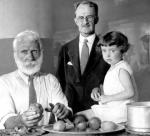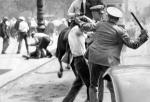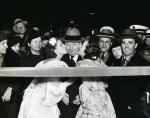![header=[Marker Text] body=[Founded by William Penn. Laid out in 1682. Chartered a city, 1701. Pennsylvania's capital until 1799; the nation's to 1800. County was on of Pennsylvania's original three, formed 1682 and consolidated with city in 1854. Name means "City of Brotherly Love."] sign](http://explorepahistory.com/kora/files/1/10/1-A-328-139-ExplorePAHistory-a0l3h8-a_450.gif)
Mouse over for marker text
Name:
Philadelphia [Great Depression]
Region:
Philadelphia and its Countryside/Lehigh Valley
County:
Philadelphia
Marker Location:
N. Broad St. (Pa. 611) and John F. Kennedy Blvd., just N of City Hall
Dedication Date:
December 16, 1982
Behind the Marker
Shortly after taking office as mayor of Philadelphia in January 1932, J. Hampton Moore remarked: "I toured the lower section of South Philadelphia. I went into the small streets, and saw little of poverty.... I have counted automobiles and watched them pass a given point. Rich and poor, white and colored, alien and native born, all riding by.... There is no starvation in Philadelphia."
Moore's upbeat observations, and reports to Washington that Philadelphia was administering its poor relief admirably, however, could not change the reality of the economic collapse of his city. In Kensington's textile mill district, one of every four household heads was jobless, and in the black neighborhoods of South Philadelphia, one of three workers was unemployed. All told, some 281,000 Philadelphians were jobless and desperately looking for work.
administering its poor relief admirably, however, could not change the reality of the economic collapse of his city. In Kensington's textile mill district, one of every four household heads was jobless, and in the black neighborhoods of South Philadelphia, one of three workers was unemployed. All told, some 281,000 Philadelphians were jobless and desperately looking for work.
Mayor Moore typified the views of the Philadelphia political and civic leaders who believed that government's primary function was to facilitate the nation's economic growth. For generations, assistance and relief for those in need had come from two sources: the charitable work of churches and other voluntary organizations; and the jobs, food, coal, favors, and other "personal services" provided by Philadelphia's Republican city machine, an entity that party boss Bill Vare in the 1920s called "the most perfect party organization in the world."
The resources available through private charity and local politicians, however, were incapable of alleviating the unprecedented mass misery wrought by the Depression. In November 1930, concerned citizens formed the Committee on Unemployment Relief and raised $3,840,000 to aid the jobless and their families, and soon operated a shelter that cared for some 12,000 homeless. Within a year, however, it ran out of money and disbanded.
A Community Chest Campaign raised $10 million from generous Philadelphians, but went out of existence after it quickly exhausted its money. Churches, soup kitchens, and breadlines did what little they could to help the hungry, but their efforts were only a drop in a large and ever growing bucket.
Funding from federal New Deal programs became available to the city after 1933, but Mayor Moore and his Republican allies in City Council accepted only a fraction of what was offered. Publicly they argued that the federal government was exceeding its powers by providing unemployment relief. Politically, they also feared that Democrat-sponsored aid dispensed from Washington would undermine the GOP's traditional appeal among the city's black, immigrant, and working class voters. Hoping to sure up the city's bond ratings, Moore also laid off city workers and cut services to balance the city's budget, and obstructed the provision of work relief by the federal government, even when more than 300,000 Philadelphians were registered at the state employment office.
When Moore refused to sign the necessary ordinances to receive Civilian Works Administration funding, federal relief administrator Harry Hopkins threatened to transfer the jobs outside the city. While Moore squabbled with the federal government about "how and where Philadelphia will spend its money," WPA state administrator Edward Jones ran out of patience and moved 12,000 Philadelphia WPA employees to projects in the suburbs.
The city's bond rating did improve, but Moore's obstinacy lost the city jobs, road improvements, public buildings, and other beneficial construction. It also helped drive voters to the city's newly re-born Democratic Party. In the fall of 1935, Democratic city leader S. Davis Wilson jumped to the Republican Party, won the election to become the Philadelphia's next mayor, and once in office immediately courted federal assistance.
At the peak of its operations in the city, the WPA alone employed more than 47,000 people, who constructed roads, bridges, schools, sewers, an airport, public housing complexes, some 900 public buildings, and improvements to Fairmount Park, the Zoo, League Island Park, the city water plant, and some 900 public buildings. And just as Mayor Moore and the Republican old guard had feared, Philadelphians shifted their political allegiance.
the city water plant, and some 900 public buildings. And just as Mayor Moore and the Republican old guard had feared, Philadelphians shifted their political allegiance.
In the 1936 presidential election more than 60 percent voted for Roosevelt; the first time a majority of Philadelphians had supported a Democrat for president since they backed the state's native son James Buchanan back in 1856.
During the depths of the Great Depression, New Deal work relief programs helped tens of thousands of Philadelphians and left a legacy of public projects still visible on the Philadelphia landscape today. Only when World War II kick-started Philadelphia's industries, however, did the city prosper.
From 1936 until 1952, Philadelphians split their ballots, voting Republican in local elections and as Democrats for president. The political realignment begun during the Great Depression culminated in 1952 when Democrat Joe Clark's election as mayor ended the eighty-four year reign of the Republican machine. From that day to the present, Philadelphia has remained a Democratic stronghold.
Moore's upbeat observations, and reports to Washington that Philadelphia was
Mayor Moore typified the views of the Philadelphia political and civic leaders who believed that government's primary function was to facilitate the nation's economic growth. For generations, assistance and relief for those in need had come from two sources: the charitable work of churches and other voluntary organizations; and the jobs, food, coal, favors, and other "personal services" provided by Philadelphia's Republican city machine, an entity that party boss Bill Vare in the 1920s called "the most perfect party organization in the world."
The resources available through private charity and local politicians, however, were incapable of alleviating the unprecedented mass misery wrought by the Depression. In November 1930, concerned citizens formed the Committee on Unemployment Relief and raised $3,840,000 to aid the jobless and their families, and soon operated a shelter that cared for some 12,000 homeless. Within a year, however, it ran out of money and disbanded.
A Community Chest Campaign raised $10 million from generous Philadelphians, but went out of existence after it quickly exhausted its money. Churches, soup kitchens, and breadlines did what little they could to help the hungry, but their efforts were only a drop in a large and ever growing bucket.
Funding from federal New Deal programs became available to the city after 1933, but Mayor Moore and his Republican allies in City Council accepted only a fraction of what was offered. Publicly they argued that the federal government was exceeding its powers by providing unemployment relief. Politically, they also feared that Democrat-sponsored aid dispensed from Washington would undermine the GOP's traditional appeal among the city's black, immigrant, and working class voters. Hoping to sure up the city's bond ratings, Moore also laid off city workers and cut services to balance the city's budget, and obstructed the provision of work relief by the federal government, even when more than 300,000 Philadelphians were registered at the state employment office.
When Moore refused to sign the necessary ordinances to receive Civilian Works Administration funding, federal relief administrator Harry Hopkins threatened to transfer the jobs outside the city. While Moore squabbled with the federal government about "how and where Philadelphia will spend its money," WPA state administrator Edward Jones ran out of patience and moved 12,000 Philadelphia WPA employees to projects in the suburbs.
The city's bond rating did improve, but Moore's obstinacy lost the city jobs, road improvements, public buildings, and other beneficial construction. It also helped drive voters to the city's newly re-born Democratic Party. In the fall of 1935, Democratic city leader S. Davis Wilson jumped to the Republican Party, won the election to become the Philadelphia's next mayor, and once in office immediately courted federal assistance.
At the peak of its operations in the city, the WPA alone employed more than 47,000 people, who constructed roads, bridges, schools, sewers, an airport, public housing complexes, some 900 public buildings, and improvements to Fairmount Park, the Zoo, League Island Park,
In the 1936 presidential election more than 60 percent voted for Roosevelt; the first time a majority of Philadelphians had supported a Democrat for president since they backed the state's native son James Buchanan back in 1856.
During the depths of the Great Depression, New Deal work relief programs helped tens of thousands of Philadelphians and left a legacy of public projects still visible on the Philadelphia landscape today. Only when World War II kick-started Philadelphia's industries, however, did the city prosper.
From 1936 until 1952, Philadelphians split their ballots, voting Republican in local elections and as Democrats for president. The political realignment begun during the Great Depression culminated in 1952 when Democrat Joe Clark's election as mayor ended the eighty-four year reign of the Republican machine. From that day to the present, Philadelphia has remained a Democratic stronghold.
Beyond the Marker









